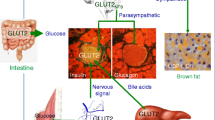Abstract
Reports that food intake is stimulated by intracerebroventricular (icv) administration of the SGLT1 Na+-D-glucose cotransport inhibitor, phlorizin, suggest that decreased central glucose uptake is a stimulus for compensatory motor activity underlying restoration of energy imbalance. In order to identify central cell populations that are functionally responsive to decreased SGLT1 function in the brain, the present study utilized immunocytochemical techniques to demonstrate cellular expression of the inducible activator protein-1 transcription factor, Fos, following icv delivery of phlorizin. Groups of adult male rats were treated with phlorizin at a dose of 10, 50, or 250 μg/animal, then sacrificed 2hr later by transcardial perfusion. Ependymal expression of Fos-immunoreactivity (-ir) was observed throughout most of the cerebroventricular system, except the medullary fourth ventricle, at each dose examined. Higher doses of the transport inhibitor elicited immunostaining of periventricular glia, characterized by cytoplasmic glial fibrillary acidic protein-ir, underlying the lateral, third, and rostral fourth ventricles and cerebral aqueduct. These doses also resulted in the transcriptional activation of neurons in discrete brain sites, including the rostral medial preoptic area, median preoptic n., preoptic and hypothalamic periventricular n., subfornical organ, thalamic medial habenular and paraventricular n., hypothalamic paraventricular, ventromedial, and arcuate n., and n. of the solitary tract. These results show that nonexcitable cells located throughout much of the central neuroaxis and discrete populations of neurons in the brain are genomically responsive to pharmacological inhibition of central SGLT1 function. Evidence for the functional responsiveness of these cell types to manipulation of energy-dependent glucose transport suggests that cellular uptake of this metabolic fuel may serve as an indicator of central energy substrate availability, and that alterations in glucose uptake via this specific mechanism may be the source of regulatory signals involved in the maintenance of energy homeostasis.
Similar content being viewed by others
REFERENCES
Mayer, J. 1995. Regulation of energy balance and body weight: the glucostatic theory and the lipostatic hypothesis. Ann. NY Acad. Sci. 63:15–43.
Mayer, J. and Thomas, D. 1967. Regulation of food intake and obesity. Science 156:228–337.
Flynn, F. W. and Grill, H. J. 1985. Fourth ventricular phlorizin dissociates feeding from hyperglycemia in rats. Brain Res. 341:331–336.
Ritter, R. C., Slusser, P. C., and Stone, S. 1981. Glucoreceptors controlling feeding and blood glucose are in the hindbrain. Science 213:451–452.
Tordoff M. G., Flynn, F. W., Grill H. J., and Friedman, M. I. 1988. Contribution of fat metabolism to ‘glucoprivic’ feeding produced by fourth ventricular 5-thio-D-glucose. Brain Res. 445:216–221.
Panayotova-Heiermann, M., Loo, D. D., Kong, C. T., Lever, J. E., and Wright, E. M. 1996. Sugar binding to Na+/glucose cotransporters is determined by the carboxyl-terminal half of the protein. J. Biol. Chem. 271:10029–10034.
Poppe, R., Karbach, U., Gambaryan, S., Wiesinger, H., Lutzenburg, M., Kraemer, M., Witte, O. W., and Koepsell, H. 1997. Expression of the Na+-D-glucose cotransporter SGLT1 in neurons. J. Neurochem. 69:84–94.
Vannucci, S. G., Maher, F., and Simpson, I. A. 1997. Glucose transporter proteins in brain: delivery of glucose to neurons and glia. Glia 21:2–21.
Lee, W. S., Kanai, Y., Wells, R. G., and Hediger, M. A. 1994. The high affinity Na+/glucose cotransporter. Re-evaluation of function and distribution of expression. J. Biol. Chem. 269:12032–12039.
Bissonnette, P., Gagne, H., Coady, M. J., Benabdallah, K., Lapointe, J. Y., and Berteloot, A. 1996. Kinetic separation and characterization of three sugar transport modes in Caco-2 cells. Amer. J. Physiol. 270:G833–843.
Brot-Larouche, E., Supplisson, S., Delhomme, B., Alcalde, A. I., and Alvarado, F. 1987. Characterization of the D-glucose/ Na+ cotransport system in the intestinal brush-border by using the specific substrate, methyl alpha-D-glucopyranoside. Biochim. Biophys. Acta 904:71–80.
Loike, J. D., Hickman, S., Kuang, K., Xu, M., Cao, L., Vera, J. C., Silverstein, S. C., and Fischbarg, J. 1996. Sodium-glucose cotransporters display sodium-and phlorizin-dependent water permeability. Amer. J. Physiol. 271:C1779–1774.
Malo, C. 1990. Separation of two distinct Na+/glucose cotransport systems in the human fetal jejunum by means of their differential specificity for 3-O-methylglucose. Biochim. Biophys. Acta 1022:8–16.
Morgan, J. I. and Curran, T. 1991. Stimulus-transcription coupling in the nervous system: involvement of the inducible protooncogenes fos and jun. Annu. Rev. Neurosci. 14:421–451.
Kasahara, T. and Kasahara, M. 1997. Characterization of rat Glut4 glucose transporter expressed in the yeast Saccharomyces cerevisiae: comparison with Glut1 glucose transporter. Biochim. Biophys. Acta 1324:111–119.
Ritzhaupt, A., Wood, I. S., Ellis, A., Hosie, K. B., and Shirazi-Beechey, S. P. 1998. Identification and characterization of a monocarboxylate transporter (MCT1) in pig and human colon: its potential to transport L-lactate as well as butyrate. J. Physiol. 513:719–732.
Roeder, L. M., Williams, I. B., and Tildon, J. T. 1985. Glucose transport in astrocytes: regulation by thyroid hormone. J. Neurochem. 45:1653–1657.
Rosenberg, P. A. and Dichter, M. A. 1985. Glycogen accumulation in rat cerebral cortex in dissociated cell culture. J. Neurosci. Meth. 15:101–112.
Schurr, A., Payne, R. S., Miller J. J., and Rigor, B. M. 1997. Brain lactate is an obligatory aerobic energy substrate for functional recovery after hypoxia: further in vitro validation. J. Neurochem. 69:423–426.
Larabee M. G. 1995. Lactate metabolism and its effects on glucose metabolism in an excised neural tissue. J. Neurochem. 64:1734–1741.
Larabee M. G. 1996. Partitioning of CO2 production between glucose and lactate in excised sympathetic ganglia, with implications for brain. J. Neurochem. 67:1726–1734.
Dringen, R. and Hamprecht, B. 1992. Glucose, insulin, and insulin-like, growth factor I regulate the glycogen content in astroglia-rich primary cultures. J. Neurochem. 58:511–517.
Dringen, R. and Hamprecht, B. 1993. Differences in glycogen metabolism in astroglia-rich primary cultures and sorbitolselected astroglia cultures derived from mouse brain. Glia 8:143–149.
Hu, Y. and Wilson, G. S. 1997. A temporary local energy pool coupled to neuronal activity: fluctuations of extracellular lactate levels in rat brain monitored with rapid-response enzyme-based sensor. J. Neurochem. 69:1484–1490.
Author information
Authors and Affiliations
Rights and permissions
About this article
Cite this article
Briski, K.P., Marshall, E.S. Induction of Ependymal, Glial, and Neuronal Transactivation by Intraventricular Administration of the SGLT1 Na+-D-Glucose Cotransporter Inhibitor Phlorizin. Neurochem Res 26, 783–792 (2001). https://doi.org/10.1023/A:1011655901032
Issue Date:
DOI: https://doi.org/10.1023/A:1011655901032




